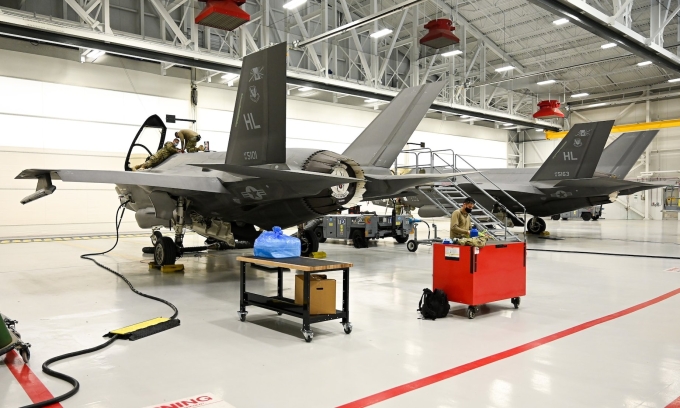
How the U.S. Can Disable Foreign F-35 Fleets Without a ‘Kill Switch’
The U.S. doesn’t need a hidden "kill switch" to disable F-35 jets operated by allied nations—simply cutting off logistics, maintenance, and software support would render the aircraft inoperable.
Earlier this month, former German defense officials claimed the U.S. had built a remote deactivation system into the F-35 stealth fighter, allowing Washington to disable the jets at will. Similar concerns surfaced in Belgium, Switzerland, and the UK, following reports that Ukraine’s F-16 fleet had been grounded due to a lack of American support.
Lockheed Martin, the F-35’s manufacturer, denied these claims, calling them baseless rumors. NATO members operating the aircraft also dismissed the allegations.
However, military analysts argue that the U.S. doesn’t need a kill switch—it already controls the F-35 program in ways that could effectively ground entire fleets if relations with an ally soured.
How the U.S. Could Ground F-35s Without a Kill Switch
"If the U.S. halts logistics and technical support, F-35 fleets will quickly become non-operational. The more advanced the weapon, the faster it deteriorates without maintenance," said Tyler Rogoway, editor at The War Zone.
Unlike other fighter jets, the F-35 is heavily dependent on U.S. oversight and support. According to U.S. Air Force policy, operators cannot conduct independent testing outside the continental U.S.. The F-35’s core software, electronic systems, and maintenance protocols are tightly controlled by American authorities.
Many F-35 components, including key electronics, are sealed before export. If a foreign operator needs repairs, they must send parts back to the U.S. for servicing. This gives Washington a powerful form of control over its allies’ fleets.
What Happens If a Country Is Cut Off from F-35 Support?
If the U.S. were to suspend access to spare parts, software updates, or key maintenance, foreign F-35 fleets would rapidly deteriorate.
Key challenges include:
-
Engine Maintenance: Pratt & Whitney, the sole provider of F-35 engines, controls maintenance schedules and parts distribution. Without access to U.S. support, engines could not be serviced or replaced.
-
Spare Parts: The F-35’s complex supply chain already struggles with shortages. If the U.S. blocked a country from purchasing spare parts, keeping jets airworthy would become nearly impossible.
-
Stealth Coating & Sensor Repairs: The F-35’s stealth capabilities require specialized facilities for repairs. Countries cannot fix these coatings independently without U.S. approval.
-
Software Access: Without updates from the U.S. cloud-based ALIS/ODIN system, F-35s lose critical battlefield intelligence, making them far less effective.
"The ALIS/ODIN network is one of the F-35’s greatest strengths," Rogoway explained. "Without it, pilots lose access to enemy radar data, target tracking, and coordination with allied forces, making the jet far more vulnerable."
Additionally, the U.S. could restrict access to satellite communication systems that connect F-35s in real time. Without these, the jets would lose key battlefield coordination capabilities, forcing pilots to rely solely on onboard sensors.
Why Israel Is an Exception
The only country outside the U.S. with partial control over its F-35s is Israel. The Israeli Air Force negotiated the right to modify and maintain its own F-35s, citing constant conflict risks that require independent operational control.
However, Israel still lacks full access to U.S. technology, particularly software updates and key electronic components.
Concerns Among NATO Allies
Many NATO members—including Germany, the UK, and Italy—are increasingly uneasy about how dependent their F-35 fleets are on Washington’s approval.
"This raises serious concerns about strategic autonomy," said aviation analyst David Cenciotti, noting that some European nations are now reconsidering their F-35 purchases.
-
Portugal recently abandoned its F-35 procurement plan, with Defense Minister Nuno Melo warning of the geopolitical risks of relying on U.S. control.
-
Canada is reviewing its $13 billion deal for 88 F-35s, with officials exploring European alternatives due to strained relations with the Trump administration.
The F-35 Precedent: How the U.S. Blocked Turkey
In 2019, Turkey was removed from the F-35 program after purchasing Russian S-400 air defense systems.
-
Ankara had already paid for 100 F-35s, and some were even built before the U.S. blocked delivery.
-
Turkey never received its aircraft, and all training, support, and software access were cut off overnight.
Conclusion: A Fighter Jet Under U.S. Control
The F-35 is unlike any previous fighter jet—its operational effectiveness is tightly bound to the U.S.
"Without American support, F-35s can be grounded in a matter of months," Rogoway emphasized. "This is a major concern for allies relying on the jet for critical missions, including nuclear deterrence."
As geopolitical tensions shift, some countries are reconsidering whether the F-35 is truly an independent capability—or just another tool Washington can wield to influence foreign policy.
(Sources: The War Zone, AFP, AP)
Hello Shuttle will strive to bring the latest updates. At the end of the day.
Are you looking for reliable airport and cruise port transfer services in Los Angeles?
We offer professional, safe, and punctual transportation from
Los Angeles Airport - LAX
Long Beach Airport - LGB
John Wayne Airport - SNA
San Pedro cruise port
Long Beach cruise port
Disneyland
and other destinations.
Let us make your journey stress-free and comfortable with our dedicated drivers and high-quality vehicles. Book now for the perfect travel experience at www.helloshuttle.com or call 944-800-5678!


